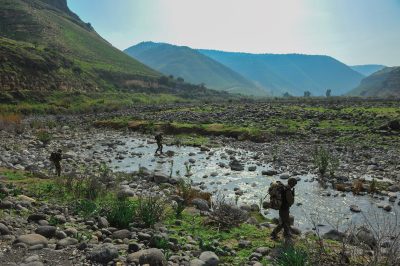×


We have detected your country as:
Please click here to go to the USA website or select another country from the dropdown list.
by: Kathy Degagne, BFP Staff Writer
 In the northeastern corner of Israel, bordering Syria and Lebanon, the Golan Heights is a sweeping plateau, rich in fertile soil for vineyards and grasslands for dairy cattle and sheep. The Golan serves as a catchment area for fresh meltwater that drains into the Sea of Galilee below. The region draws thousands of tourists each year who are eager to view the spectacular waterfalls of Saar and Banias that flow from Mount Hermon into the tributaries of the Jordan River and water the lush Galilee.
In the northeastern corner of Israel, bordering Syria and Lebanon, the Golan Heights is a sweeping plateau, rich in fertile soil for vineyards and grasslands for dairy cattle and sheep. The Golan serves as a catchment area for fresh meltwater that drains into the Sea of Galilee below. The region draws thousands of tourists each year who are eager to view the spectacular waterfalls of Saar and Banias that flow from Mount Hermon into the tributaries of the Jordan River and water the lush Galilee.
There is an intrinsic link between the Jewish people and the Golan Heights. The Golan has been their ancestral homeland since Joshua’s conquest of Canaan, when the half tribe of Manasseh was given Bashan, present-day Golan (Num. 32) as their inheritance.
Ancient Jewish presence in the Golan is evidenced by the over 30 synagogues and numerous second-century Jewish coins that have been uncovered in archaeological excavations. Though the Jewish presence has been interrupted by exile and conquest, Jews have continually returned to the Golan to settle the land, till the soil and tend their livestock, rebuilding their lives on the same land from which they were banished.
Israel has legal, historical and security claims to the Golan, but the enemies of the Jewish state will do everything in their power to take it away. Though important to Israel for many reasons, the significance of the Golan can be essentially summed up in one word: security. The Golan’s elevated terrain ensures that whoever holds the region holds the strategic advantage in battle, making the Golan dangerous territory for Israel if it ever falls into the wrong hands. From the Golan, Israel’s enemies could launch a strike at any time—and strike they will if Israel ever lets its guard down.
 Israel learned that lesson the hard way between 1948 and 1967 when Syria held the Golan and showered the towns of the Galilee below with unprovoked, deadly sniper fire. Slated to be part of Israel after the Balfour Declaration, Britain turned the Golan over to France in the Sykes-Picot Agreement. France eventually ceded the Golan to Syria in 1944. In 1967, Syria lost its claim to the Golan when it attacked Israel and then lost the war. For Israelis, the Six Day War was not an offensive war calculated to increase Israel’s territory, it was a battle for their very survival.
Israel learned that lesson the hard way between 1948 and 1967 when Syria held the Golan and showered the towns of the Galilee below with unprovoked, deadly sniper fire. Slated to be part of Israel after the Balfour Declaration, Britain turned the Golan over to France in the Sykes-Picot Agreement. France eventually ceded the Golan to Syria in 1944. In 1967, Syria lost its claim to the Golan when it attacked Israel and then lost the war. For Israelis, the Six Day War was not an offensive war calculated to increase Israel’s territory, it was a battle for their very survival.
Aware that it would never be secure if the Golan was not in their hands, Israel annexed the territory in 1981 by passing the Golan Heights Law. Legally, Israel was entitled to the territory because it had gained the land fighting a war of defense. The United Nations, woefully ignorant of Israel’s security issues without the Golan, called the annexation “null and void.” In an absurd move, the international community adjudicated that the Golan be ceded to a nation whose sole intention was to annihilate Israel.
As if history had not already proven that point, during the 1973 Yom Kippur War, Syria launched a surprise attack on the Golan and almost overran the country. Outnumbered by Syrian tanks—177 Israeli against 1,400 Syrian—Israel managed to repel the attack, though with heavy losses.
After 1973, Israel’s relationship with Syria can be described as a cold war: a diplomatic freeze with a few displays of belligerence, but no outright conflict. However, the situation became more volatile during the Arab Spring in 2011 and the subsequent Syrian Civil War, as Iranian troops and Iran’s terror proxy Hezbollah used the distraction of the civil war to entrench themselves along the Syrian/Golan border.
The Golan has long been used as a bargaining chip in land-for-peace negotiations between Syria and Israel. However, since the Syrian Civil War, peace talks have ceased altogether, and Syria has chosen to back terrorist groups such as Hezbollah and Hamas in their fight against Israel. The Golan has again become a thorn in the side of Syrian President Bashar al-Assad. For Syria, recovering the Golan has become a priority, and they intend to use “every possible means to liberate the Golan.”
Another major power player in the region is Russia, who supported Assad in the civil war under the pretense of fighting the Islamic State. Russia is now virtually controlling Syria and may be looking to the oil and gas resources of the Golan as a prize for the massive amounts of money spent on Assad’s behalf. Netanyahu made it clear to Russian President Vladimir Putin that the Golan was a “red line” that Israel would not allow Syria, Hezbollah or Iran to cross. Israeli sovereignty of the region is nonnegotiable. Israelis agreed, proclaiming, “Ha’am im HaGolan!” (The people are with the Golan).
After decades of weak-kneed US foreign policy, President Donald Trump bucked international opinion and recognized Israeli sovereignty over the Golan on March 21, 2019. That announcement coincided with Purim (Feast of Esther), the holiday that celebrates the rescue of the Jews in Persia (Iran) from annihilation. “After 52 years [since 1967] it is time for the United States to fully recognize Israel’s sovereignty over the Golan Heights,” Trump tweeted, “which is of critical strategic and security importance to the State of Israel and regional stability.”
Prime Minister Netanyahu affirmed the announcement as “historic justice” by a non-Jewish leader on behalf of the people of Israel. As for the Golan and the many costly battles fought on its land, “Israel holds the high ground,” Netanyahu declared, “and we shall never give it up.”
All logos and trademarks in this site are property of their respective owner. All other materials are property of Bridges for Peace. Copyright © 2024.
Website Site Design by J-Town Internet Services Ltd. - Based in Jerusalem and Serving the World.